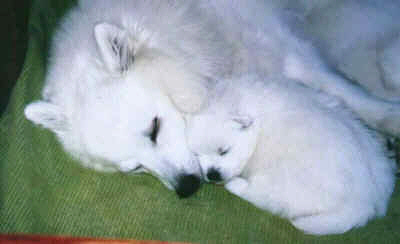|
The Japanese Spitz is a truly adaptable dog that can live happily in the coldest and hottest climates around the world? Height: 10"-16" Often confused with the American Eskimo, the Japanese Spitz is actually a descendant of the Siberian Samoyed. So similar are its characteristics that these dogs are often referred to as miniature Samoyeds. However, the energy level is much less "wired" than the American Eskimos. The JS will can do agile events with you, or is quite content to sit on the couch beside you, while you watch TV or read--his energy level is yours. The other major difference is that the JS is always white and always small, to achieve this in the American Eskimo is less common, they come in many colors and not generally small in size. Development of the Japanese Spitz began in the late 1800s, but it wasn't until 1921 that the breed was first exhibited at a dog show in Tokyo. Bred for their smaller size, these dogs made wonderful companion dogs and were especially favored in Japan in the 1950s. Their friendly personalities made them the perfect family pet and their smaller size made them extremely convenient. Today, the Japanese Spitz has become increasingly popular in North America and Europe. As a family pet, the Japanese Spitz excels. Lively, affectionate, and quick to learn, this breed aims to please and take part in family activities, loves children and will happily play for hours. These are all-round good companions. Whether you're watching TV on the couch or playing Frisbee in the park, this dog simply thrives on human company. Consistent and gentle training goes a long way with this breed. The Japanese Spitz enjoys agility, games, and learning tricks. They are obedient and will get along with other household pets. A small dog with big attitude, the courageous Japanese Spitz also makes a good little watchdog. Most are suspicious of strangers, and may have a tendency to be more sensitive to strange sounds and let you know. Fairly active, even indoors, the Japanese Spitz will do fine living in an apartment. However, these are athletic dogs and do need a long daily walk, as well as regular opportunities to run in an enclosed area. Their thick and pure white coat needs is "Teflon like" and a short daily brushing/combing is all that is necessary. The texture of the outer coat allows dirt and mud to drop off as soon as it dries, so bathing once or twice a year will be sufficient. This is generally a healthy breed. There have been cases of patellar luxation, so be sure that breeding stock is checked for this condition. As with all white breeds, sometimes cosmetic staining around the eyes may be noticed. ADDRESSING THE STAININGAn assortment of remedies have been suggested to resolve the cosmetic reddish stains that result from tear drainage on white furred animals. Our genetic lines are bred with a wider nose resulting in no staining. Here are some comments or suggestions that we have heard:
|
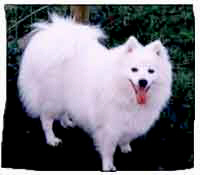

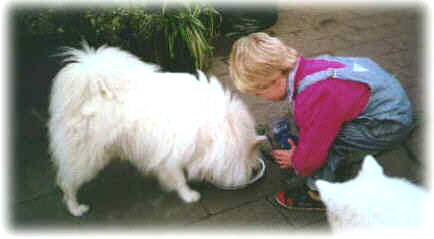

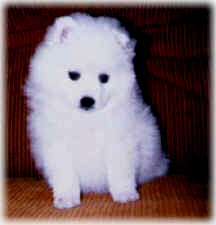
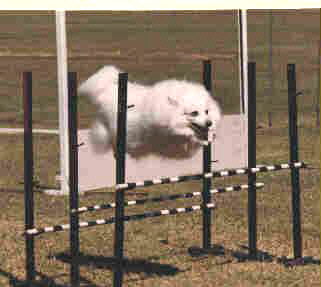 Agility events can be fun for them and their owners as
well.
Agility events can be fun for them and their owners as
well.